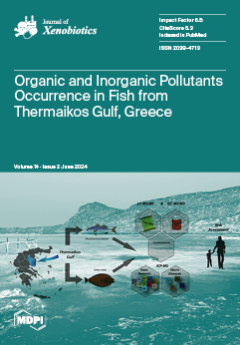The monitoring of contaminants in fish species is pivotal for fishes’ health and reproduction, as well as for human health. In the specific work, three major categories of contaminants, pesticides, pharmaceuticals, and macro and trace elements, were investigated in two major fish species,
[...] Read more.
The monitoring of contaminants in fish species is pivotal for fishes’ health and reproduction, as well as for human health. In the specific work, three major categories of contaminants, pesticides, pharmaceuticals, and macro and trace elements, were investigated in two major fish species,
Dicentrarchus labrax and
Solea solea, collected from Thermaikos Gulf, in Greece. To achieve this goal, three analytical methods using LC-MS/MS, GC-MS/MS, and ICP-MS were developed, validated, and applied to the collected fish samples. The results indicated a very low prevalence of caffeine and acetaminophen, both not exceeding 3.8 μg/kg fish. Similarly, thiabendazole, cypermethrin, and tricyclazole (pesticides) were found in a concentration range of 0.9 to 13.7 μg/kg fish, while in one
D. labrax sample, traces of the metabolite of organochlorine pesticide DDT,
o,p’-DDE were detected. Al, Mn, Fe, Zn, and Sr were the predominant trace elements in a concentration range of 500–20,000 μg/kg fish. Macro elements levels varied from 280 to 5405 mg/kg fish. Health risk assessment did not unveil an unacceptable risk for the human health of adults, apart from one sample presenting Hg above the regulatory levels. On the contrary, for children, the calculated hazard quotient values for Hg in all cases and for two As detections were higher than the threshold value of 1, indicating a potential risk.
Full article






